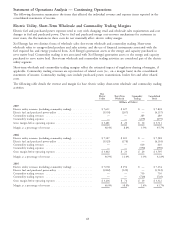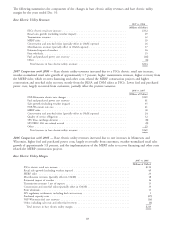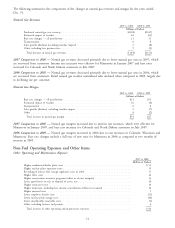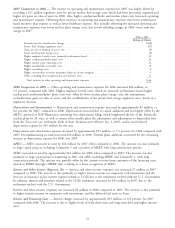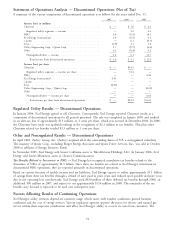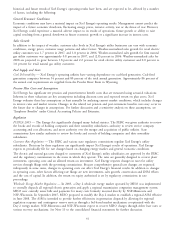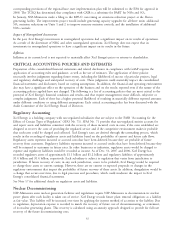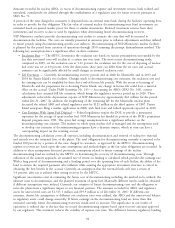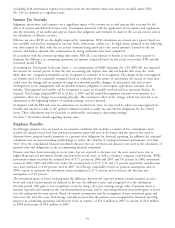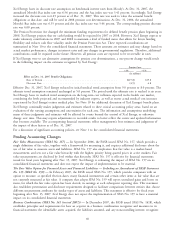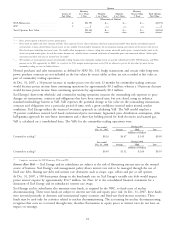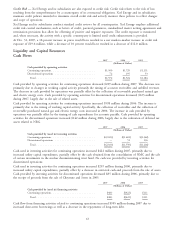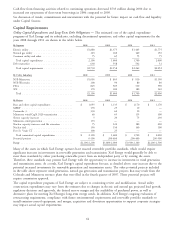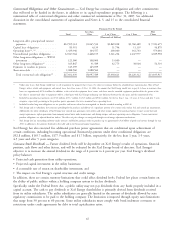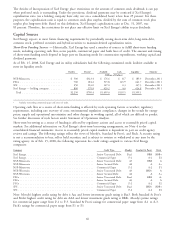Xcel Energy 2007 Annual Report Download - page 67
Download and view the complete annual report
Please find page 67 of the 2007 Xcel Energy annual report below. You can navigate through the pages in the report by either clicking on the pages listed below, or by using the keyword search tool below to find specific information within the annual report.corresponding provisions of the regional haze state implementation plan will be submitted to the EPA for approval in
2008. The TCEQ has determined that compliance with CAIR is a substitute for BART for NOx and SO2.
In January, NSP-Minnesota made a filing to the MPUC concerning an emissions reduction project at the Sherco
generating facility. The improvement project would include generating capacity upgrades for all three units; additional
SO2 emission reductions on Units 1 and 2 to improve mercury emission controls; and the installation of additional
NOx controls.
Impact of Nonregulated Investments
In the past, Xcel Energy’s investments in nonregulated operations had a significant impact on its results of operations.
As a result of the divestiture of NRG and other nonregulated operations, Xcel Energy does not expect that its
investments in nonregulated operations to have a significant impact on its results in the future.
Inflation
Inflation at its current level is not expected to materially affect Xcel Energy’s prices or returns to shareholders.
CRITICAL ACCOUNTING POLICIES AND ESTIMATES
Preparation of the consolidated financial statements and related disclosures in compliance with GAAP requires the
application of accounting rules and guidance, as well as the use of estimates. The application of these policies
necessarily involves judgments regarding future events, including the likelihood of success of particular projects, legal
and regulatory challenges and anticipated recovery of costs. These judgments could materially impact the consolidated
financial statements and disclosures, based on varying assumptions. In addition, the financial and operating environment
also may have a significant effect on the operation of the business and on the results reported even if the nature of the
accounting policies applied have not changed. The following is a list of accounting policies that are most critical to the
portrayal of Xcel Energy’s financial condition and results, and that require management’s most difficult, subjective or
complex judgments. Each of these has a higher potential likelihood of resulting in materially different reported amounts
under different conditions or using different assumptions. Each critical accounting policy has been discussed with the
Audit Committee of the Xcel Energy Board of Directors.
Regulatory Accounting
Xcel Energy is a holding company with rate-regulated subsidiaries that are subject to the FASB ‘‘Accounting for the
Effects of Certain Types of Regulation’’ (SFAS No. 71). SFAS No. 71 provides that rate-regulated entities account for
and report assets and liabilities consistent with the recovery of those incurred costs in rates, if the rates established are
designed to recover the costs of providing the regulated service and if the competitive environment makes it probable
that such rates could be charged and collected. Xcel Energy’s rates are derived through the ratemaking process, which
results in the recording of regulatory assets and liabilities based on the probability of current and future cash flows.
Regulatory assets represent incurred or accrued costs that have been deferred because they are probable of future
recovery from customers. Regulatory liabilities represent incurred or accrued credits that have been deferred because they
will be returned to customers in future rates. In other businesses or industries, regulatory assets would be charged to
expense and regulatory liabilities would be recorded as income. As of Dec. 31, 2007 and 2006, Xcel Energy has
recorded regulatory assets of approximately $1.1 billion and $1.2 billion and regulatory liabilities of approximately
$1.4 billion and $1.4 billion, respectively. Each subsidiary is subject to regulation that varies from jurisdiction to
jurisdiction. If future recovery of costs, in any such jurisdiction, ceases to be probable, Xcel Energy would be required
to charge these assets to current earnings. However, there are no current or expected proposals or changes in the
regulatory environment that impact the probability of future recovery of these assets. In addition, deregulation would be
a change that occurs over time, due to legal processes and procedures, which could moderate the impact to Xcel
Energy’s consolidated financial statements.
See Note 17 for additional details on regulatory assets and liabilities.
Nuclear Decommissioning
NSP-Minnesota owns nuclear generation facilities and regulations require NSP-Minnesota to decommission its nuclear
power plants after each facility is taken out of service. Xcel Energy records future plant removal obligations as a liability
at fair value. This liability will be increased over time by applying the interest method of accretion to the liability. Due
to regulation, depreciation expense is recorded to match the recovery of future cost of decommissioning, or retirement,
of its nuclear generating plants. This recovery is calculated using an annuity approach designed to provide for full rate
recovery of the future decommissioning costs.
57



